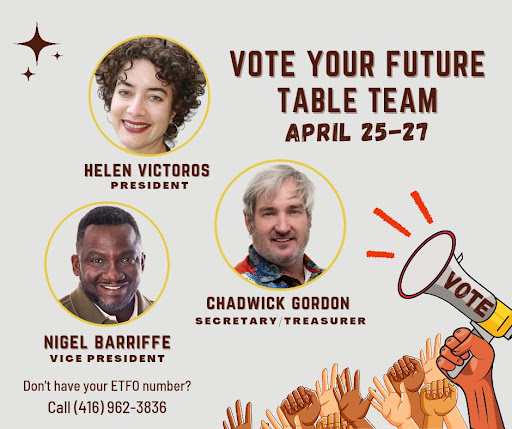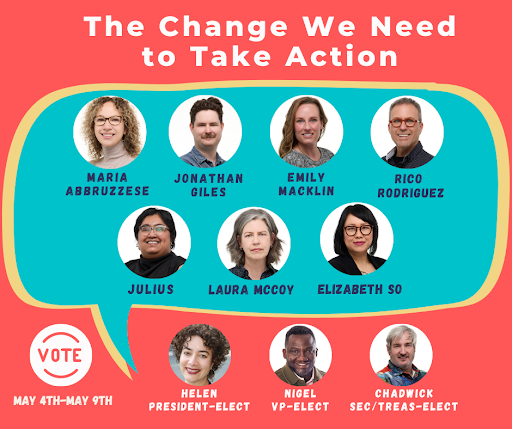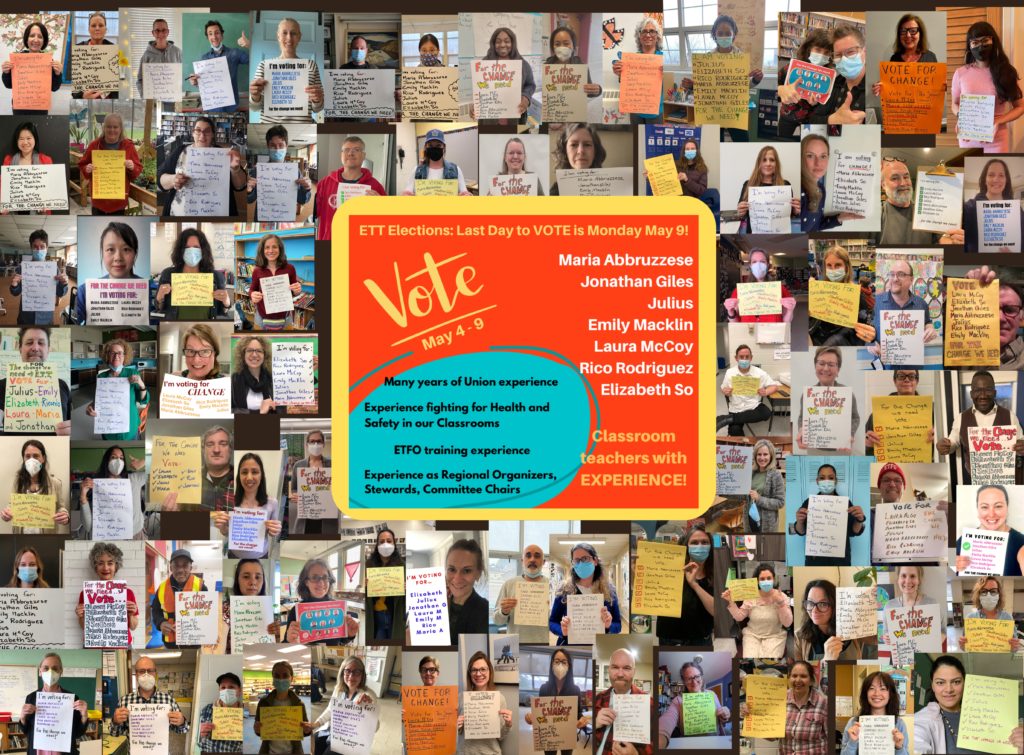8. 17. 2022
How To Overhaul a Union Local
Karen Jutzi
Elizabeth So
We knew from the start that what we were asking from our union local’s members was unprecedented. In the Elementary Teachers of Toronto (ETT) local of the Elementary Teachers’ Federation of Ontario (ETFO), it’s unusual for a non-incumbent to unseat an incumbent from the executive in a general election. This year, a number of us ran as a progressive slate made up of two incumbents and eight non-incumbents, some of whom had never run before. The incumbents, Helen and Nigel, running for president and vice president respectively, were well-known and well-loved. But we wondered: would their appeal alone be enough to convince union members to vote for the rest of the team?

Amidst the pandemic, a struggle for the soul of a union local
Spring 2020 was a difficult time for progressives in our union. The pandemic had forced schools online in the midst of the election for our local’s executive. Teachers struggled to switch to virtual learning models; we worried about what kind of safety standards would be in place in schools when we returned to in-person learning in the fall. That spring’s ETT election saw progressive leaders ousted from the local’s top positions, although they maintained positions on the executive. We had attempted to create and elect a progressive caucus, which we called Building Union Power – without success, overall. Though it shuffled their positions, the election left in place the same 14 members of the executive: six progressives interested in a high-participation, organizing union (democratic, member-led, rooted in workers’ immense collective power), and eight who favoured the status quo – a service/business-model union (top-heavy and transactional, an organization providing a service in exchange for dues). The only difference was that after the election, the president and vice president belonged to the service-union model alliance of eight. The high-participation, organizing-model executive members were still in the minority, but now without those top positions.
Much change occurred in the 2020-2021 school year, as a virtual school of 60,000 students was created (37% of all elementary students in the board) and educators teaching in person faced unprecedented health and safety issues. The ETT executive decided against creating new supports specifically for virtual teachers working from home, as other ETFO locals had done. This left those teachers isolated, unaware of who their virtual colleagues were or who to contact about the repeated contract violations they were experiencing. With no help from their union in meeting that moment’s unique challenges, they reached out to each other on social media.
ETT members Julius and Peter started a Facebook group for virtual teachers, which became the site of a great deal of organizing. A vital support community formed in that group, spurred by members’ experience that when they most needed their union, it was not there for them. Peter and Julius led a variety of initiatives to set boundaries on virtual teachers’ workload (such as setting up out-of-office automatic email replies over the weekend) and to help members navigate ETT general meetings (a workshop on the meeting procedures known as Robert’s Rules, for example).
This Facebook group also became a place to promote petitions members wanted to send to the local’s executive to demand changes. Members launched petitions to call for more accessible and transparent general meetings, dedicated supports for virtual teachers, and a campaign to advocate for more safety in schools. The executive took no significant action in response.
These petitions’ list of signatories, however, became an email list that ETT member Karen used to inform other members of union events and executive mismanagement. That email list turned into a way to keep people informed about how the majority of the union executive were not acting in our best interests – a way to agitate for change. As members increasingly saw their executive as unresponsive, it built an appetite within them to remove that group of leaders from power.
As there were far fewer educators teaching virtually during the 2021-2022 school year, the Facebook group was not quite as active that year, but the relationships that had been developed there remained. Through social media and the email list, members continued to expose the executive’s failings. Members who wanted to chat during general meetings formed a WhatsApp group, which evolved into a community – one that would support the 2022 election work that was to come.

Taking back our local
About eight weeks before the ETT executive election in the spring of 2022, a number of us began holding strategy meetings. Attending these meetings were candidates for the election and strong supporters. Some attendees were members of the Building Union Power progressive caucus from the previous election; others were newly engaged in this work. Not everyone present agreed to join the Building Union Power caucus, but all of us nevertheless adhered to an organizing model of unionism: talking with every union member, organizing to take on the key issues that members identify, building strong structures in each of our schools and local-wide to lay the groundwork for effective direct action, and prioritizing relationship-building with parents and community groups.
A decision was made: we would run as a slate that included Helen Victoros, running for president; Nigel Barriffe, running for vice president; Chadwick Gordon, running for secretary-treasurer; as well as executive officer candidates Maria Abbruzzese, Jonathan Giles, Julius, Emily Macklin, Laura McCoy, Rico Rodriguez, and Elizabeth So. At strategy meetings, we discussed how we would track support for our slate, how we were going to organize that and other data, and what our vision and messaging would look like. We decided to track our members by recording their names, worksite, ward, executive officer, and contact person on our slate. We would also track whether they pledged to vote for us and whether they actually voted. This list gave us a live reading of where our support was concentrated, and allowed us to see who was connected to whom, which aided in our outreach to people we didn’t know very well. Such tracking also acted as an accountability chart; it kept people accountable to their commitments to reach out to and follow up with members. All of this planning was done virtually, through Zoom, WhatsApp, Google Docs, and Google Sheets.
We enlisted supportive teachers to speak to members about voting for our slate. We created a list of those who expressed great eagerness to get more involved with the election campaign and the union as a whole. We then invited all of these key contacts to an organizing meeting.
More than 30 members from our trusted contacts list attended that meeting. Once we’d all gathered, we introduced our slate, which comprised mostly active classroom teachers, teaching either in person or virtually. Having first-hand experience with pandemic teaching made us more relatable and credible when we shared our vision and the changes we wanted to implement. We had inspirational speakers in presidential candidate Helen Victoros and vice-presidential candidate Nigel Barriffe, both of them incumbent executive officers with vast community connections and strong reputations for being responsive to members.
To assist our key supporters in their conversations with other members, we shared talking points that summarized our vision, as well as some prepared responses to anticipated questions. We gave those supporters tracking sheets with which they could keep track of pledged votes. They would send their tracking sheets to their contact person from our slate, who would enter all the data into a main spreadsheet that tallied the number of pledged votes. We asked our key supporters to reach out again, when the polls opened, to the members they had previously spoken to and confirm those members had indeed voted.
Traditionally, incumbents would spend time campaigning by visiting schools, holding social events, calling members, and sending out mass mailings. But the pandemic meant many members weren’t inclined to attend in-person social events. Nor were they receptive to calls or emails. Members felt abandoned by incumbents who were now contacting them for the first time during their hardest years of teaching. Executive officers hadn’t been making visits to schools during the height of the pandemic, and many executive officers hadn’t replaced those with virtual meetings.
Taking these circumstances into account, our electoral coalition relied heavily on social media to communicate with members. We made infographics – on how to vote, where to find your ETFO member number, the list of candidates – and posted them on teacher Facebook groups. We spoke with members via Facebook Messenger, WhatsApp, and text messaging. In one very effective social media campaign, we asked supporters to take a photo of homemade signs that declared they’d voted for our slate. We created a massive collage out of those pictures and launched it during the election.

Unprecedented results for unprecedented times
Many educators in our local felt abandoned by union leadership during an extremely difficult two years of pandemic teaching. Many felt their union was not working and were happy to vote for change, but it wasn’t easy to convince exhausted and demoralized teachers that their vote could indeed make a difference.
Our key supporters and even members of our slate had doubts as well. Some did not see the value of vote-tracking; they found it tedious, complicated, and time-consuming. Some also felt tracking was intrusive: that voting was a personal matter and they did not want to be surveilled. The data team (Karen, Elizabeth, and John) eased these people’s reluctance by, for example, offering to compile just member numbers and the schools associated with them instead of member names.
All that hard work paid off. Our slate’s candidates for president and vice president, Helen Victoros and Nigel Barriffe, won by roughly 500 votes. Chadwick Gordon, our candidate for secretary-treasurer, won with a margin of fewer than 100 votes, a win that was significant because Chadwick was running against a longtime incumbent of the executive. It was also the first time ever that an electoral candidate who wasn’t yet on the executive managed to unseat an incumbent in one of the local’s top three positions.
This result energized members for the second round of voting, which would elect the remaining 11 executive officers. Our slate got about 50% more first-round votes than we had tracked, which meant that we were reaching more people indirectly. Optimism grew. But we stressed to our key supporters that the second round results could be much different. It was one thing to ask members to vote for two well-known incumbents and one additional person those incumbents publicly supported. It was quite another to ask members to vote for seven brand new candidates over seven longtime incumbents.
Before the second-round voting, we held another meeting with our supporters, stressing that without a majority, our new slate would not be able to take significant action. We released graphics on social media that showed our newly elected president, vice president, and secretary-treasurer endorsing our seven other candidates.
In the end, our election strategy was more successful than any of us could have imagined. Not only were all seven of our candidates elected, ousting three incumbents in the process, but all of our candidates received more votes than any of the four incumbents who did manage to keep their positions.
Our results were unprecedented, but so was the pandemic, and there was never a time in our union’s history when we needed our union more and they fell so far short. Our messaging, organizing, and getting the vote out during the election campaign were crucial, but so was the groundwork laid over two long years. We spent that time developing relationships with people who wanted more from their union, inviting them to participate, exposing them to the shortcomings of our union leadership, and dreaming with them about how things could be better. After the 2020 election, we wanted different results. We knew that if we wanted different results, we had to come up with a different strategy and connect with members in ways we had never done before. So that’s what we did!

Karen Jutzi has been a member of her union, the Elementary Teachers of Toronto local of the Elementary Teachers’ Federation of Ontario, since 2000. She has served as a school steward for many years and became more deeply involved in committee work and organization in 2020. She hopes the success of the last election will result in greater member engagement and more wins for workers.
Elizabeth So has been an active member for over 10 years with the Elementary Teachers of Toronto local of the Elementary Teachers’ Federation of Ontario. She has been involved in varying capacities such as committee work, organizing, and 2 AM scheming with Karen. Elizabeth was recently elected as an executive officer, and is excited to transform her union alongside 10,000 ETT members. She resides in Toronto with her partner, and is raising her two kids gender-open.
Related:
- Moments of Vast Possibility Solidarity Winnipeg’s Jesslyn Best and Leslie Ep discuss utopias, popular uprisings, gender and sexual freedom, communist politics, and speculative fiction with M.E. O’Brien and Eman Abdelhadi, the authors of the new book Everything For Everyone: An Oral History of the New York Commune, 2052-2072.
- What We Mean by Community is Our Yearning for Communism M.E. O’Brien on family abolition and the communizing of care as political horizons worth fighting for. A conversation with Midnight Sun editor David Camfield.
- Protest & Pleasure: A Revolution Led by Sex Workers A conversation with Monica Forrester, Toni-Michelle Williams, and Chanelle Gallant about why trans women of colour sex workers are the leaders we need, lighting the way to revolutionary horizons.
- Festivals of the Possible Megan Kinch on the Occupy movement, which erupted 10 years ago: its particular blend of spontaneity, organization, and technology; the forms it took in Toronto and elsewhere in Canada; and its mixed legacies. A personal and political reflection.
Related:
- Moments of Vast Possibility Solidarity Winnipeg’s Jesslyn Best and Leslie Ep discuss utopias, popular uprisings, gender and sexual freedom, communist politics, and speculative fiction with M.E. O’Brien and Eman Abdelhadi, the authors of the new book Everything For Everyone: An Oral History of the New York Commune, 2052-2072.
- What We Mean by Community is Our Yearning for Communism M.E. O’Brien on family abolition and the communizing of care as political horizons worth fighting for. A conversation with Midnight Sun editor David Camfield.
- Protest & Pleasure: A Revolution Led by Sex Workers A conversation with Monica Forrester, Toni-Michelle Williams, and Chanelle Gallant about why trans women of colour sex workers are the leaders we need, lighting the way to revolutionary horizons.
- Festivals of the Possible Megan Kinch on the Occupy movement, which erupted 10 years ago: its particular blend of spontaneity, organization, and technology; the forms it took in Toronto and elsewhere in Canada; and its mixed legacies. A personal and political reflection.
